Bark for Midwinter Interest
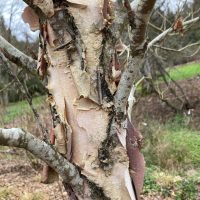
1) Betula nigra River Birch
Native to the eastern U.S., B. nigra typically inhabits the banks of ponds and waterways, often where the ground is inundated for several weeks at a time.
In stark contrast to other white-barked species, trunks of B. nigra are often forked very low and are covered with large flakes of curling, blackish bark.
This tree can be found along Arboretum Creek, just east of parking lot #19 (the ‘Birch’ lot).
February 2022 Plant Profile: Fine Foliage of Large-Leaf Rhododendrons

The species of Rhododendron in the subsection Grandia are all native to southeast Asia, though they blend into our PNW conifer and mixed forests magically. Now is an excellent time to come visit these amazing plants in the Washington Park Arboretum before the distraction of so much color enters the world.
Read moreLunar New Year and the Legend of the Mai Flower
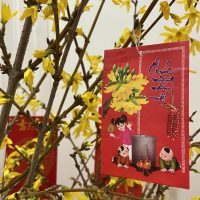
Each country has its own traditions associated with the new year. For Vietnamese families, we love to decorate our homes with the yellow Mai flower (Ochna integerrima). As if on cue, the buds push forth an explosion of delicate golden flowers during the days leading up to Lunar New Years, called Tết in Vietnamese. Read more about the legend surrounding the beautiful Mai flower.
Read moreChampion Trees of the Washington Park Arboretum
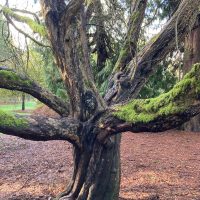
A champion tree is the largest tree of a species. These trees are measured using the American Forests points (AF points) which is calculated based on the trunk circumference, the height, and the average crown spread to give a point value. The Arboretum has many champion trees which were identified by Robert Van Pelt in his 2003 book, “Champion Trees of Washington State”.
Read moreWinners of the 2021 Snow Trials!
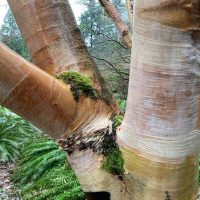
1) Betula albosinensis var. septentrionalis Chinese Red Birch
These beautiful birches show off the delicate pink, cream, and copper colors of their peeling bark in the Witt Winter Garden.
The delicate twigs of the birch shed snow, while the trunk bark glows in comparison to the white.
“Septentrionalis” generally means “northern” and refers to the seven oxen which make up the Ursa Major constellation in the northern sky.
A Berry Colorful Winter Beginning
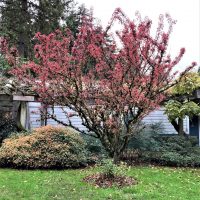
1) Malus ‘Adirondack’ Adirondack Crabapple
A small deciduous, sun-loving tree with multi-seasonal interest.
Mass amounts of dark pink buds open to form large fragrant white blossoms in late spring as new foliage emerges.
After flowering, it becomes heavily laden with seemingly glowing, pink, cherry-like fruit which last well into winter.
Rightfully so, this stunning little tree has received the “Award of Garden Merit” from the Royal Horticultural Society.
UW Farm Weekly Dirt: Reflections on Native American Heritage Month
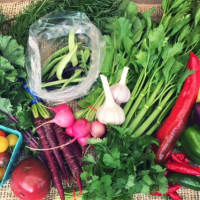
Around The Farm
All over the nation many individuals and families will be celebrating Thanksgiving this week. What that looks like depends on a number of things, including where you live, access to food, and history of your culture. There are regional differences and different views on this holiday.
November is also Native American Heritage Month and as a result many valuable sources of this American (or European) tradition are readily available.
Featured Plants from the Washington Park Arboretum
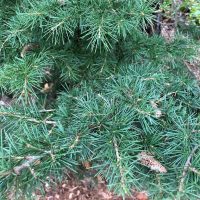
1) Cedrus libani ‘Nana’ Dwarf Cedar of Lebanon
Cedar of Lebanon forests once covered vast areas of the eastern Mediterranean, but 5,000 years of human impacts have left wild populations restricted to mountainous regions of Turkey, Syria, and Lebanon.
The resin from the Cedrus libani was used by Egyptians for embalming their dead.
This dwarf cultivar usually grows to about 15 feet tall and wide, while the species can reach over 100 feet tall.
Selected Plants from the Pacific Connections Garden-New Zealand Forest
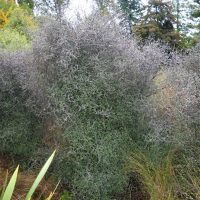
1) Corokia cotoneaster Wire-netting Bush
The common name of this species of Corokia aptly describes its wiry branches and tangled growth form. Growing into a dense bush of 1-3 meters, it has small dark-green or bronze leaves.
A native of New Zealand, C. cotoneaster is found in dry and stony places throughout its homeland, and is extremely tolerant of dry and exposed conditions.
Selected Plants From the Garden of Dr. Wott

Although Dr. John A. Wott, retired Professor Emeritus, Urban Horticulture at the University of Washington and former Washington Park Arboretum Director, recently passed at the age of 82, his work and his plants continue on at the Arboretum. His garden was full of rare, unusual, and fascinating plants and these are a few of the plants that were donated to the Arboretum by Dr.
Read more